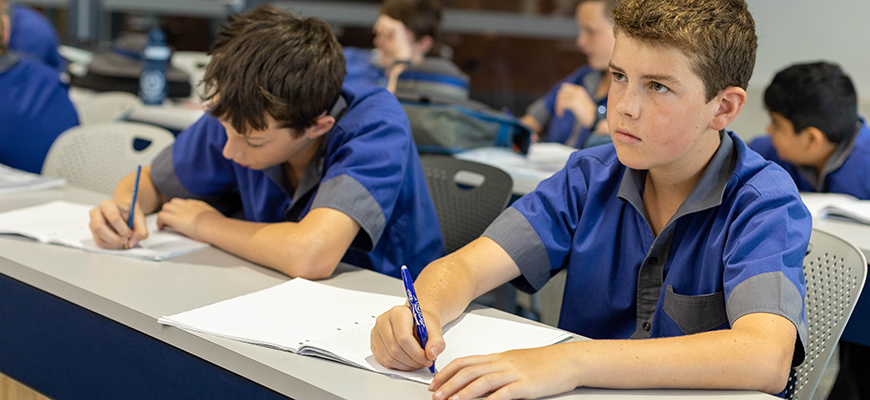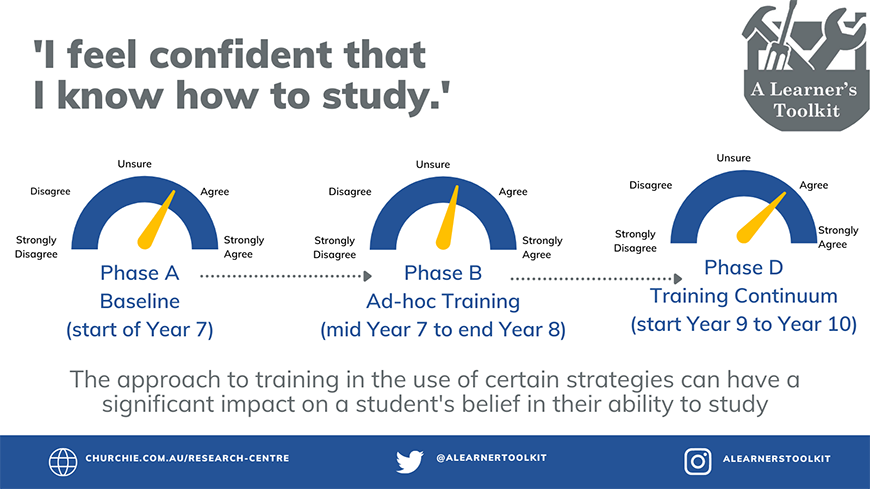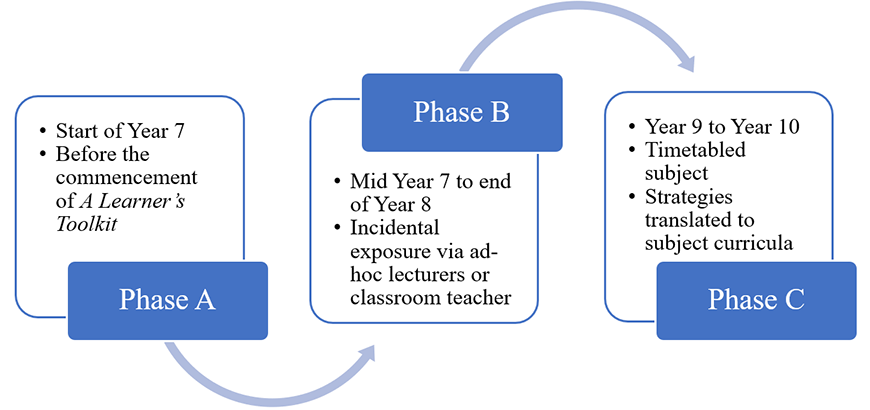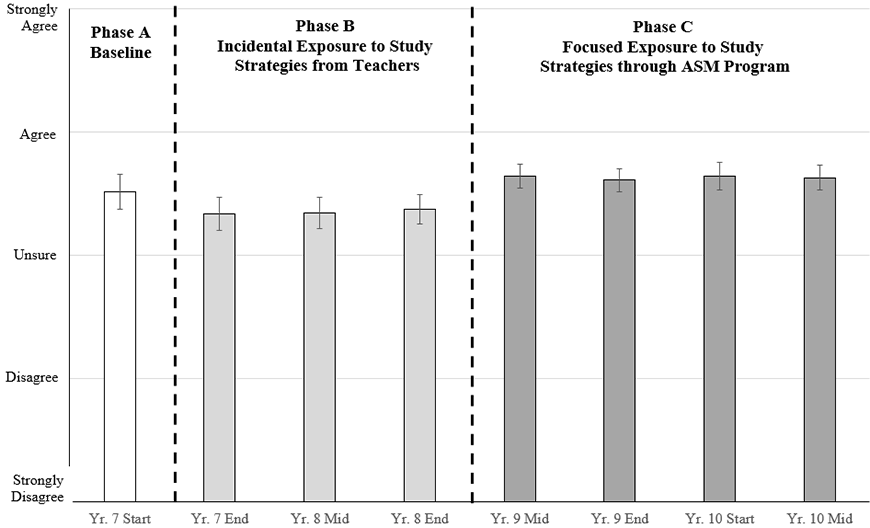4 Nov 2021
Impact of A Learner’s Toolkit on student study beliefs

The Churchie Research Centre has created a suite of strategies to provide high school students with the most effective study strategies drawn from proven behaviours and research in the field of cognitive psychology. The result is A Learner’s Toolkit. The toolkit is part of Churchie’s broader teaching and learning programme. The Churchie Research Centre is also sharing the research and toolkit with schools in Australia and around the world to assist all students in their learning journey. Additional information about this initiative can be found at the 2022 Open-access A Learner’s Toolkit Expression of Interest form.

Scope of the Study
The analysis of the A Learner’s Toolkit journey, designed in consultation with The University of Queensland’s (UQ) Science of Learning Research Centre (SLRC), is the subject of an invited chapter in the special edition of an international journal. This post is the first of a series of research bites into the emerging findings of this four-year initiative (commencing in 2018). The A Learner’s Toolkit journey (see Figure 1) at Churchie is focused on the preparatory and proactive equipping of high-utility strategies and routines. Unlike many reactive approaches, its novel earlier intervention seeks to equip the boys with those efficient behaviours and effective strategies that will aid their learning now and into their futures. Over the past three years, we have evaluated the impact of different exposure interventions to A Learner’s Toolkit on study behaviours and strategies. The study focuses on the initial pilot cohort of those who commenced their secondary schooling at Churchie in 2018.

Data Analysis
The repeated measures survey data from 2018 (collected semesterly) was analysed through a combination:
- Visual analysis of means with Cousineau-Morey 95% Cis—to in level, trend, and variability within and between-group responses from the baseline and through Phases B and C.
- One-way Repeated Measures Analysis of Variance (RM-ANOVA)—to ascertain the occurrence of a statistically significant effect of either training approach in either phase.
- Effect sizes through Tau-U calculations—justified the outcomes of the visual analysis process by measuring the degree of non-overlap between the phases, taking into account level, trend and variability.
Together, this approach illuminated if any changes found in the cohort responses were due to the nature of each training intervention or some other confounding variables (i.e., assessment, curricula and maturation).
Did student belief in their ability to study change over time?
Student belief in their ability did change throughout Phases A, B and C (Figure 2), often referred to as the transition phase of schooling (Jindal‐Snape, Hannah, Cantali, Barlow, & MacGillivray, 2020). From higher assessment Phase A to B, the student self-assessment declined. Beliefs around one’s ability to study are thought to be tied to students’ embedded strategy-values derived from their own experience, messaging (from teachers, peers, and parents), and success (Nolen & Haladyna, 1990). This decline through Phase B suggests that student strategy-values and self-efficacy around studying had been negatively affected. This decrease in belief coincides with the timing of the ‘dip’ often cited in the middle years of schooling (Years 7 to 9) phase (Jindal‐Snape et al., 2020; Pendergast et al., 2005; Symonds & Galton, 2014). It could also speak to the observation that students become aware of the limitation of their academic abilities at this stage of their schooling (Pendergast et al., 2005, p. 5). Limitation in academic ability often stems from weakening achievement and engagement (Symonds & Galton, 2014) in the face of increased academic difficulty (Jindal‐Snape et al., 2020). The correlation between a decline in academic ability and attainment disrupts students’ self-concept of critical learner behaviours (i.e. competency and self-efficacy) (Symonds & Galton, 2014). The confluence of negative experiences and feelings associated with declining achievement underpins the reduction in belief in their ability to study.

The visual analysis through Phase C found a statistically significant improvement in student perception of their ability to study. The RM-ANOVA identified a significant time [F(6, 145) = 6.07, p < 0.001] and a Tau-U effect between Phase B and C of .42. A significant improvement was surprising given that the middle years dip continues into Year 9 (Jindal‐Snape et al., 2020; Pendergast et al., 2005). The analysis suggested that the shift from ad-hoc to explicit training in the same set of strategies positively affected student belief for this sample. The explicit training approach also reduced the variation (across the cohort) in belief. Furthermore, this sample assessed their ability to study more effectively and consistently than previous cohorts at Churchie (Byers, Leighton, & Krzensk, 2021).
Reference List
Byers, T., Leighton, V., & Krzensk, A. (2021). Innate study behaviours and study strategies used by adolescent male students: A single school case study. Churchie Research Centre. doi:10.13140/RG.2.2.28772.50564/1
Jindal‐Snape, D., Hannah, E. F., Cantali, D., Barlow, W., & MacGillivray, S. (2020). Systematic literature review of primary‒secondary transitions: International research. Review of Education, 8(2), 526-566.
Pendergast, D., Flanagan, R., Land, R., Bahr, M., Mitchell, J., Weir, K., . . . Carrington, V. (2005). Developing lifelong learners in the middle years of schooling. Ministerial Council on Education, Employment, Training, and Youth Affairs (MCEETYA): Canberra, Australia.
Symonds, J. E., & Galton, M. (2014). Moving to the next school at age 10–14 years: An international review of psychological development at school transition. Review of Education, 2(1), 1-27. doi:10.1002/rev3.3021
)
)
)
)
)